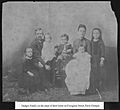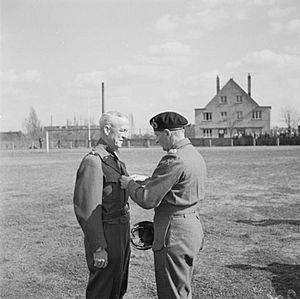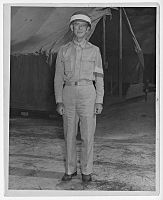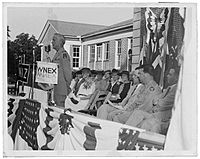Courtney Hodges facts for kids
Quick facts for kids
Courtney Hodges
|
|
|---|---|
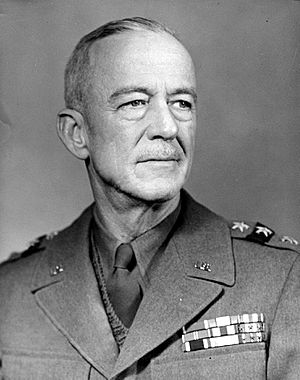
Hodges as a lieutenant general, 1944
|
|
| Born | January 5, 1887 Perry, Georgia, United States |
| Died | January 16, 1966 (aged 79) San Antonio, Texas, United States |
| Buried | |
| Allegiance | United States |
| Service/ |
United States Army |
| Years of service | 1906–1949 |
| Rank | General |
| Service number | 0-2686 |
| Unit | Infantry Branch |
| Commands held | First United States Army Third United States Army X Corps Army Ground Forces Infantry School, Fort Benning 2nd Battalion, 6th Infantry Regiment |
| Battles/wars |
|
| Awards |
|
| Spouse(s) |
Mildred Lee Buchner
(m. 1928) |
General Courtney Hicks Hodges (born January 5, 1887 – died January 16, 1966) was an important leader in the United States Army. He commanded the First U.S. Army during the Western European Campaign of World War II. Hodges was special because he started as a regular soldier (a private) and worked his way up to become a top general.
Born in Perry, Georgia, he first went to the United States Military Academy (West Point) but left because he struggled with geometry. He joined the Army in 1906 as a private. He quickly moved up through the ranks and became an officer in 1909 after passing a special test.
As a young man, Hodges served under Colonel John J. Pershing in a mission in Mexico called the Pancho Villa Expedition. He was also part of the first rescue mission in U.S. military aviation history when he helped save a pilot whose plane was stuck. During World War I, he led a group of soldiers (a battalion) in France. He won the Distinguished Service Cross for being incredibly brave.
In 1943, he went to England to work with General Omar Bradley. Hodges was the second-in-command of the First Army during the D-Day invasion. Two months later, he became the commander of the First Army. Under Hodges, his First Army was huge, with 18 different groups of soldiers. This was more than any other general commanded directly in the European theater of World War II. The First Army helped free Paris, was the first Allied army to enter Germany, and even split Nazi Germany in half by meeting up with Soviet soldiers.
Contents
Early Life and Army Start
Courtney Hodges was born in Perry, Georgia, on January 5, 1887. He was the fourth of eight children in his family. The Hodges family came to America from England in 1750. After the American Revolution, they moved to Houston County, Georgia.
Courtney's father, John, owned the local newspaper, Houston Home Journal. Courtney went to Perry High School and finished in 1903. Later, he enrolled at North Georgia Agricultural College, which is now the University of North Georgia.
After his first year at North Georgia, he got a chance to go to the United States Military Academy (USMA) at West Point. He would have finished with the Class of 1909, but he left after a year because he found geometry too difficult. After leaving West Point, he worked at a grocery store for a year.
In 1906, Hodges joined the United States Army as a private. He was sent to the 17th Infantry at Fort McPherson, Georgia. He quickly became a sergeant. In 1909, he did very well on a test to become an officer. He was made a second lieutenant in the Infantry in November, just a few months after his West Point classmates graduated. He was then sent to the 13th Infantry. Early in his career, he served with future Army Chief of Staff, George C. Marshall, in the Philippines. He also served with future General George S. Patton in Mexico.
Early Missions and World War I
Hodges served in Fort Leavenworth, Kansas, in San Antonio, Texas, and in the Philippine Islands. His first important military mission was under Brigadier General John J. Pershing. This mission went into Mexico to capture Pancho Villa, a Mexican bandit who had attacked Columbus, New Mexico in 1916. This mission was one of the first times the US army used airplanes in a fight. Hodges made history when he was sent to rescue a pilot whose plane was stuck. This was the first such rescue mission in U.S. military aviation history.
Hodges served with the 6th Infantry Regiment during World War I, which America joined in April 1917. He became a lieutenant colonel and led a group of soldiers (a battalion) in the 6th Infantry. He fought in the St Mihiel and Meuse-Argonne campaigns in 1918. In the Meuse-Argonne campaign, he led a scouting group across the Meuse River and got past the German lines. He held a position under heavy enemy fire for 20 hours. Their location became the front of the American advance across the Meuse. During the war, he won the Distinguished Service Cross for being incredibly brave while leading an attack across the Marne River.
After the war, Hodges stayed in Germany as part of the occupying forces. From 1920 to 1924, he worked at West Point. Then, he studied and graduated from the United States Army Command and General Staff College in 1925. He then taught at the United States Army Infantry School in Fort Benning, Georgia, until 1926. He also taught at the Air Corps Tactical School in Alabama until 1929.
For the next four years, he was part of a group that made decisions about infantry at Fort Benning. Hodges then finished the United States Army War College in 1934. In 1938, he became an assistant leader of the Army Infantry School, before becoming the main leader in 1940. While he was there, he became good friends with Omar Bradley, who would be very important in Hodges's future army career.
World War II Leadership
In May 1941, Hodges was promoted to major general. He had different jobs, including Chief of Infantry, until he was given command of the X Corps in 1942. This group was stationed in the United States. In 1943, he was promoted to lieutenant general. He continued to command X Corps and then the Third Army. When the Third Army moved from the United States to England for the planned invasion of Europe, General George Patton Jr. took command. Hodges became the second-in-command of the First Army under General Omar Bradley.
During Operation Overlord in June and July 1944, Hodges served under Bradley as the deputy commander of the First Army. In August 1944, Hodges took over from Bradley as the commander of the First Army. This happened when Bradley moved up to lead the 12th Army Group. Hodges served under Bradley and General Dwight D. Eisenhower until Nazi Germany surrendered in May 1945.
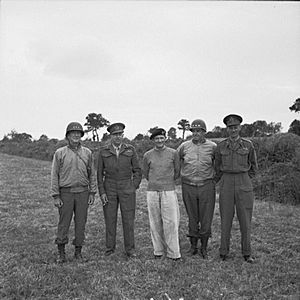
Hodges' First Army moved quickly across France. They helped to free Paris on August 25, 1944. Then, they led the way through France, Belgium, and Luxembourg towards Germany. General Hodges' troops were the first Allied soldiers to enter Germany. They reached the German border (northwest of Trier) on September 11, 1944.
During the British attack on Arnhem, called Operation Market Garden, supplies were mainly given to the Anglo-Canadian 21st Army Group. The First Army was sent north of the Ardennes. Their job was to make small attacks to draw German defenders south, away from the main targets.
Hodges' troops played a big part in stopping the German counterattack in the Ardennes, known as the Battle of the Bulge. When the German advance cut the First Army off from the 12th Army Group and Bradley, Hodges' First Army was temporarily placed under the command of the Anglo-Canadian 21st Army Group. This group was led by Field Marshal Bernard Montgomery. The First Army was also joined by the Ninth United States Army. This happened on December 20, 1944. The First Army returned to the 12th Army Group on January 17, 1945.
Before, during, and after the Battle of the Bulge, the First Army fought the Germans in the Battle of Aachen. They also fought in the 5-month long Battle of Hurtgen Forest to the southeast of Aachen. This was part of the main US effort to break through the Siegfried Line and advance through Germany to the Roer River. Hodges led the First Army to free most of Luxembourg in three days, from September 9 to September 12, 1944. The city of Aachen was captured on October 22. However, the German counter-offensive and the Battle of the Bulge happened before other goals could be met. Once the Battle of the Bulge was won, the Hürtgen Forest was taken. On February 10, the Rur Dam was finally captured. The total cost of the Siegfried Line Campaign for American soldiers was about 140,000.
By March 7, 1945, the 9th Armored Division of the First Army captured the Ludendorff Bridge at Remagen. The First Army was the first enemy of Germany to cross the Rhine River since the Napoleonic Wars. The bridge collapsed after 10 days. By then, the First Army had built two strong bridges across the Rhine. They had also created a secure area 40 kilometers (25 miles) long, from Bonn in the north to almost Koblenz in the south. This area was 10 to 15 kilometers (6.2 to 9.3 miles) deep and held by five U.S. divisions. They advanced slowly, waiting for Montgomery and the 21st Army Group to launch Operation Plunder across the Rhine on March 23.
Together with the U.S Ninth Army, the First Army trapped 300,000 German troops in the Battle of the Ruhr Pocket. A month later, Hodges' troops from the First Army met soldiers from the Soviet Red Army near Torgau on the Elbe River. Hodges was promoted to the rank of four-star general on April 15, 1945. He became one of only two soldiers in U.S. Army history to rise from private to general. The other was Walter Krueger, who served in the Southwest Pacific.
Omar Bradley said about Hodges, "No other leader and no other armed force unit in World War II is entitled to greater credit than that which belongs to the quiet, modest General Courtney Hicks Hodges and his First Army." Eisenhower called Hodges the "spearhead and the scintillating star" of the United States advance into Germany. He wanted to make sure Hodges was recognized for his achievements, even though he was "seemingly overlooked by the headline writers."
After World War II ended in Europe on May 7, 1945, Hodges and the First Army were told to get ready to go to the Pacific for the planned invasion of Japan. This was supposed to happen in late 1945 to March 1946. However, this move was not needed when the Japanese Empire surrendered. The official surrender documents were signed in Tokyo Bay on September 2, 1945. Hodges was one of the very few people present at the surrenders of both Nazi Germany in Reims, France, and the Japanese Empire at Tokyo Bay.
-
US Army General Courtney Hodges (left) greets Soviet Army Major General Gleb Baklanov (right) after the meeting of Soviet and US forces on the Elbe
Later Life and Legacy
After World War II, Hodges continued to command the First Army at Fort Jay on Governors Island, New York. He retired in March 1949. Later, he worked as a Military Advisor to Sir Owen Dixon, who was a United Nations Mediator for Kashmir.
On June 22, 1928, Hodges married Mildred Lee Hodges (Mildred Lee Buchner). She was a young widow. They did not have any children.
Hodges died in San Antonio, Texas, in 1966. He was buried at Arlington National Cemetery.
In Perry, Georgia, a road called State Route 7 Spur was named General Courtney Hodges Boulevard after him. A road in Dinant (Belgium) is named Avenue Général Hodges. In Maastricht (Netherlands), the Generaal Hodgesstraat is also named after him.
Even though he was a strong and skilled commander, Hodges was a quiet person. He was not very well known to his troops, despite efforts to make him more popular.
Images for kids
-
Painting of General Hodges at the Museum of Aviation
Awards
Hodges received many honors and awards, including:
United States
| Distinguished Service Cross | |
| Army Distinguished Service Medal with two Oak Leaf Clusters | |
| Silver Star | |
| Bronze Star Medal | |
| Mexican Service Medal | |
| World War I Victory Medal with three Campaign Stars | |
| Army of Occupation of Germany Medal | |
| American Campaign Medal | |
| Asiatic-Pacific Campaign Medal | |
| European-African-Middle Eastern Campaign Medal with five service stars | |
| World War II Victory Medal |
Foreign Awards
 Knight Commander of the Order of the British Empire (United Kingdom)
Knight Commander of the Order of the British Empire (United Kingdom) Grand Officer of the Legion of Honour (France)
Grand Officer of the Legion of Honour (France) Grand Officer of the Order of Leopold (Belgium)
Grand Officer of the Order of Leopold (Belgium) Companion of the Order of the Bath (United Kingdom)
Companion of the Order of the Bath (United Kingdom) Grand Officer of the Order of the Liberator San Martin (Argentina)
Grand Officer of the Order of the Liberator San Martin (Argentina) Order of Suvorov (USSR)
Order of Suvorov (USSR) Order of the Oak Crown (Luxembourg)
Order of the Oak Crown (Luxembourg) Croix de Guerre 1939-1945 with palm (France)
Croix de Guerre 1939-1945 with palm (France) Croix de Guerre 1939–1945 with palm (Belgium)
Croix de Guerre 1939–1945 with palm (Belgium)
Dates of Rank
| Insignia | Rank | Group | Date |
|---|---|---|---|
| No insignia | Cadet | United States Military Academy | June 16, 1904 (Left June 17, 1905.) |
| Various | Enlisted | Regular Army | May 1, 1906 |
| No insignia in 1909 | Second lieutenant | Regular Army | November 13, 1909 |
| First lieutenant | Regular Army | July 1, 1916 | |
| Captain | Regular Army | May 15, 1917 | |
| Major | National Army | June 7, 1918 | |
| Lieutenant colonel | National Army | October 31, 1918 | |
| Major | Regular Army | July 1, 1920 | |
| Lieutenant colonel | Regular Army | October 1, 1934 | |
| Colonel | Regular Army | October 1, 1938 | |
| Brigadier general | Regular Army | April 1, 1940 | |
| Major general | Regular Army | May 1, 1941 | |
| Lieutenant general | Army of the United States | February 16, 1943 | |
| General | Army of the United States | April 15, 1945 | |
| General | Retired List | March 31, 1949 |
See also
 In Spanish: Courtney Hodges para niños
In Spanish: Courtney Hodges para niños



